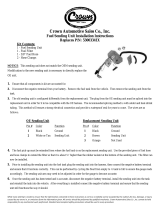Dakota Digital STRC is a vacuum fluorescent digital dashboard that provides the driver with up-to-date and accurate information on the operation of his or her vehicle. The STRC uses state-of-the-art vacuum fluorescent display technology to give the driver superior performance and visual appeal over LCD or LED display systems.
The STRC has many features that are not typically found on other brands or types of instrumentation, including:
- Digital accuracy and solid-state reliability
- Superior daytime visibility and computer-controlled dimming for nighttime driving
- Multiple display options, including a speedometer, tachometer, odometer/trip odometer, gear shift indicator, and turn signals/high beam indicators
Dakota Digital STRC is a vacuum fluorescent digital dashboard that provides the driver with up-to-date and accurate information on the operation of his or her vehicle. The STRC uses state-of-the-art vacuum fluorescent display technology to give the driver superior performance and visual appeal over LCD or LED display systems.
The STRC has many features that are not typically found on other brands or types of instrumentation, including:
- Digital accuracy and solid-state reliability
- Superior daytime visibility and computer-controlled dimming for nighttime driving
- Multiple display options, including a speedometer, tachometer, odometer/trip odometer, gear shift indicator, and turn signals/high beam indicators














-
 1
1
-
 2
2
-
 3
3
-
 4
4
-
 5
5
-
 6
6
-
 7
7
-
 8
8
-
 9
9
-
 10
10
-
 11
11
-
 12
12
-
 13
13
-
 14
14
Dakota Digital STRC Technical Manual
- Type
- Technical Manual
- This manual is also suitable for
Dakota Digital STRC is a vacuum fluorescent digital dashboard that provides the driver with up-to-date and accurate information on the operation of his or her vehicle. The STRC uses state-of-the-art vacuum fluorescent display technology to give the driver superior performance and visual appeal over LCD or LED display systems.
The STRC has many features that are not typically found on other brands or types of instrumentation, including:
- Digital accuracy and solid-state reliability
- Superior daytime visibility and computer-controlled dimming for nighttime driving
- Multiple display options, including a speedometer, tachometer, odometer/trip odometer, gear shift indicator, and turn signals/high beam indicators
Ask a question and I''ll find the answer in the document
Finding information in a document is now easier with AI
Related papers
-
Dakota Digital STR4D User manual
-
Dakota Digital RET-2001 User manual
-
Dakota Digital 3 User manual
-
Dakota Digital 3X Series User manual
-
Dakota Digital STR6D-92C-PU User manual
-
Dakota Digital 3X Series User manual
-
Dakota Digital VHX-92C-PU-U Technical Manual
-
Dakota Digital VFD3-88C-PU-U Technical Manual
-
Dakota Digital VHX Technical Manual
-
Dakota Digital HLY-2 Technical Manual
Other documents
-
Intellitronix M9107 Installation guide
-
Intellitronix MS9107B Operating instructions
-
Ames 2445800 Installation guide
-
luminii Place Installation guide
-
luminii Set Installation guide
-
Intellitronix MS9001B Installation guide
-
Intellitronix DP7002 Installation guide
-
 Crown Automotive 53003341X Installation guide
Crown Automotive 53003341X Installation guide
-
BENDIX TCH-010-005 User manual
-
VDO Speed alert Installation Instructions Manual














